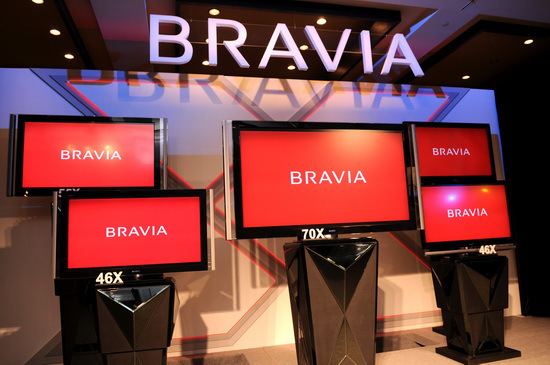Retail availability 2005 to present Related articles | ||
 | ||
Type mainly LCD & Organic light-emitting diode HDTV Menu interface | ||
BRAVIA is a brand of Sony Visual Products Inc., a wholly owned subsidiary of Sony Corporation, and used for its television products. Its backronym is "Best Resolution Audio Visual Integrated Architecture". All Sony high-definition flat-panel LCD televisions in North America have carried the logo for BRAVIA since 2005. BRAVIA replaces the "LCD WEGA" which Sony used for their LCD TVs until Summer 2005 (early promotional photos exist of the first BRAVIA TVs still bearing the WEGA moniker). Bravia televisions and their components are manufactured in Sony's plants in Japan, Mexico, and Slovakia for their respective regions and are also assembled from imported parts in Brazil, Spain, China, Malaysia and Ecuador. Principal design work for BRAVIA products is performed at Sony's research facilities in Japan, at the research and development department at the Sony de Mexico facility in Baja California, Mexico and at the Sony Europe facility in Nitra, Slovakia.
Contents
- Accessories
- Sony Bravia Internet TV and Video
- Green TV
- Mobile phones
- Internals
- Upgrading and maintenance
- References
The brand is also used on mobile phones in North American, Japanese and European markets.
In 2014, in part of Hirai's plans to turn Sony around, BRAVIA was made into an subsidiary rather than just a brand of products.
In May 2015 Sony launched their first lineup of Android television Bravia models, which allows users to easily access content from services like YouTube, Netflix and Hulu as well as install apps and games from the Google Play Store. Noteworthy for being the first Android TV available.
In September 2016, Sony announced that TVs older than 2012 will lose access to YouTube.
Accessories
In April 2007, Sony launched the BRAVIA TDM-IP1, a docking cradle to permit playback of audio and video hosted on an Apple iPod on a BRAVIA model television.
Current accessories available include a Skype camera (CMUBR100) and Wi-Fi adapter (UWABR100).
Sony Bravia Internet TV and Video
Sony Bravia Internet Video first became available in late 2009 on Internet enabled Bravia TV's, later becoming available on Sony Blu-ray and home theatre systems. The original Bravia Internet Video was built around Sony's XMB interface and had several streaming media partners including: Amazon Video On Demand, YouTube, Yahoo!, Netflix and Sony Video (Qriocity). 2011 saw a revamp of Bravia Internet Video, with a rework of the interface and an added Skype capability.
Sony Bravia Internet TV is the first TV to incorporate Google TV, currently only available in the US it plans to revolutionize IPTV.
XBR8 is a series of Sony BRAVIA LCD High Definition Televisions. They were released into the US marketplace starting in September 2008.
The 46- and 55-inch models of the XBR8 series features an RGB LED backlight system which Sony calls Triluminos. The new backlight system is claimed to provide a truer and higher color spectrum and allows this series of televisions to rival plasma displays in terms of dark blacks. This model also marked the debut of Sony's new video processor, the BRAVIA Engine 2 Pro. The display panel uses ten-bit processing and offers the 120 Hz MotionFlow technology.
The XBR8 line offers two screen sizes; the 46" (KDL-46XBR8) was released on September 29, 2008. The second model, the 55" (KDL-55XBR8) became available for order in October 2008.
Green TV
For sale in Japan on July 30, 2008, Sony's green product, a new flat-panel 32-inch TV for 150,000 yen (US$1,400; €900) BRAVIA KDL-32JE1 offers ecological consumers the advantage of 70% less energy consumption than regular models with same image quality. For consumers who rely on electricity generated from carbon dioxide emitting sources, it reduces carbon dioxide emissions totaling 79 kilograms (174 pounds) a year.
Mobile phones
Sony uses a BRAVIA image processing engine in high-end mobile devices produced by its Sony Ericsson communications arm (now Sony Mobile Communications), starting with the Xperia arc model in 2011. Subsequent flagship models of Sony's smartphone range such as the Xperia S, and Xperia Z use enhanced versions of the BRAVIA engine.
In addition, BRAVIA brand phones have been produced by Sony/Sony Ericsson. BRAVIA brand phones are able to watch 1seg terrestrial television.
Internals
The LCD panels within BRAVIA TVs are manufactured by Sony corporation with a special architecture. Since 2010, high end Bravia LX, HX and selected NX series use 10th gen Sony Bravia ASV panel. The 8th gen SPVA panel from Sony LCD continue to serve other midrange and budget Bravia models.
Many Sony televisions with USB connectivity run Linux.
Upgrading and maintenance
The software can be upgraded via a USB type A interface labeled "DMEx / service only" and via the Internet for later models.
2006–2007 models may be updated using Memory Stick or USB. Depending upon the country and TV standard the Tuner may need a Service Device to update it.
It appears that units manufactured through November 2005 for sale in Asia and North America contained a software bug that prevented the device from powering up/down after 1200 hours. A free upgrade is available.
